Analysis of Legal and Ethical Issues in Healthcare: Edward's Case
VerifiedAdded on 2020/02/03
|9
|2692
|127
Essay
AI Summary
This essay delves into the legal and ethical complexities surrounding healthcare decisions, using the case of Edward, who is in a coma, to illustrate key issues. It examines the legal authority of healthcare providers, the elements required for valid consent, and the rationale for legal obligations when a patient lacks decision-making capacity. The essay explores potential options for healthcare providers, particularly when disagreements arise among surrogate decision-makers, highlighting factors to consider when withdrawing life-sustaining measures. Furthermore, it analyzes the ethical principles at play, referencing the Universal Declaration on Bioethics and Human Rights, and identifies potential conflicts among stakeholders. The essay concludes by applying an ethical problem-solving model to the scenario, emphasizing the importance of considering available facts, ethical principles, and relevant laws to arrive at informed decisions in such sensitive situations. The essay emphasizes the importance of patient rights, informed consent, and the ethical considerations in end-of-life care.
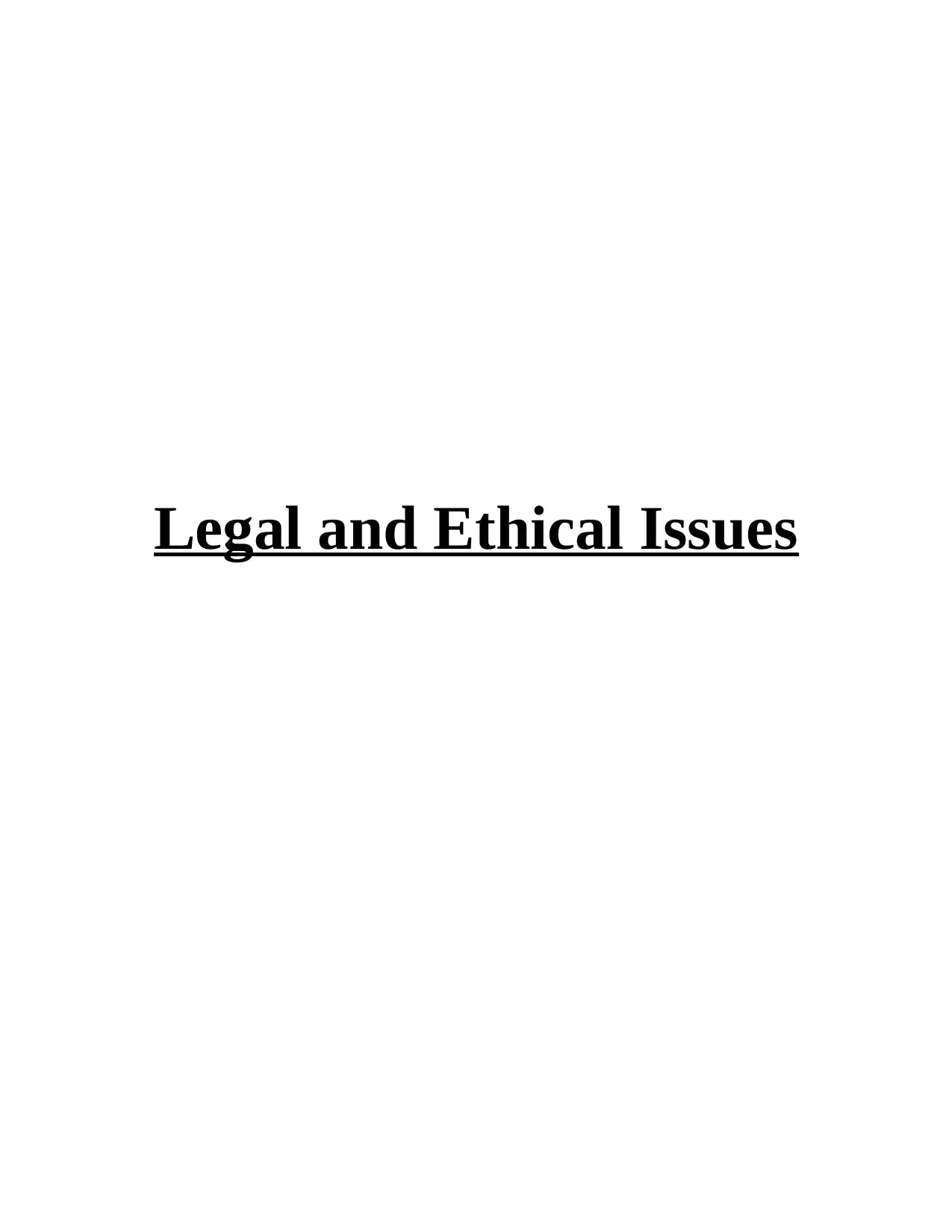
Legal and Ethical Issues
Paraphrase This Document
Need a fresh take? Get an instant paraphrase of this document with our AI Paraphraser

TABLE OF CONTENTS
REFERENCES................................................................................................................................9
2
REFERENCES................................................................................................................................9
2
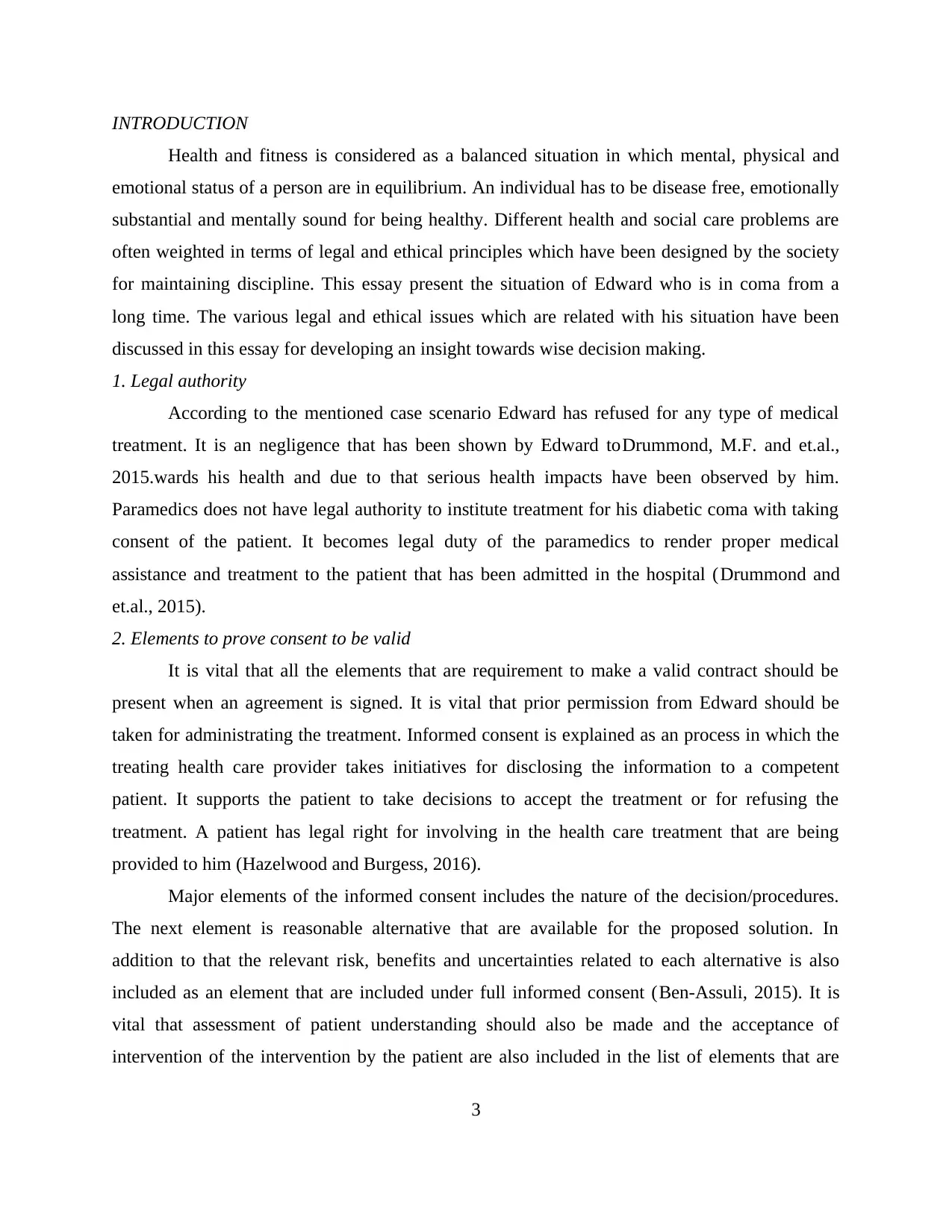
INTRODUCTION
Health and fitness is considered as a balanced situation in which mental, physical and
emotional status of a person are in equilibrium. An individual has to be disease free, emotionally
substantial and mentally sound for being healthy. Different health and social care problems are
often weighted in terms of legal and ethical principles which have been designed by the society
for maintaining discipline. This essay present the situation of Edward who is in coma from a
long time. The various legal and ethical issues which are related with his situation have been
discussed in this essay for developing an insight towards wise decision making.
1. Legal authority
According to the mentioned case scenario Edward has refused for any type of medical
treatment. It is an negligence that has been shown by Edward toDrummond, M.F. and et.al.,
2015.wards his health and due to that serious health impacts have been observed by him.
Paramedics does not have legal authority to institute treatment for his diabetic coma with taking
consent of the patient. It becomes legal duty of the paramedics to render proper medical
assistance and treatment to the patient that has been admitted in the hospital (Drummond and
et.al., 2015).
2. Elements to prove consent to be valid
It is vital that all the elements that are requirement to make a valid contract should be
present when an agreement is signed. It is vital that prior permission from Edward should be
taken for administrating the treatment. Informed consent is explained as an process in which the
treating health care provider takes initiatives for disclosing the information to a competent
patient. It supports the patient to take decisions to accept the treatment or for refusing the
treatment. A patient has legal right for involving in the health care treatment that are being
provided to him (Hazelwood and Burgess, 2016).
Major elements of the informed consent includes the nature of the decision/procedures.
The next element is reasonable alternative that are available for the proposed solution. In
addition to that the relevant risk, benefits and uncertainties related to each alternative is also
included as an element that are included under full informed consent (Ben-Assuli, 2015). It is
vital that assessment of patient understanding should also be made and the acceptance of
intervention of the intervention by the patient are also included in the list of elements that are
3
Health and fitness is considered as a balanced situation in which mental, physical and
emotional status of a person are in equilibrium. An individual has to be disease free, emotionally
substantial and mentally sound for being healthy. Different health and social care problems are
often weighted in terms of legal and ethical principles which have been designed by the society
for maintaining discipline. This essay present the situation of Edward who is in coma from a
long time. The various legal and ethical issues which are related with his situation have been
discussed in this essay for developing an insight towards wise decision making.
1. Legal authority
According to the mentioned case scenario Edward has refused for any type of medical
treatment. It is an negligence that has been shown by Edward toDrummond, M.F. and et.al.,
2015.wards his health and due to that serious health impacts have been observed by him.
Paramedics does not have legal authority to institute treatment for his diabetic coma with taking
consent of the patient. It becomes legal duty of the paramedics to render proper medical
assistance and treatment to the patient that has been admitted in the hospital (Drummond and
et.al., 2015).
2. Elements to prove consent to be valid
It is vital that all the elements that are requirement to make a valid contract should be
present when an agreement is signed. It is vital that prior permission from Edward should be
taken for administrating the treatment. Informed consent is explained as an process in which the
treating health care provider takes initiatives for disclosing the information to a competent
patient. It supports the patient to take decisions to accept the treatment or for refusing the
treatment. A patient has legal right for involving in the health care treatment that are being
provided to him (Hazelwood and Burgess, 2016).
Major elements of the informed consent includes the nature of the decision/procedures.
The next element is reasonable alternative that are available for the proposed solution. In
addition to that the relevant risk, benefits and uncertainties related to each alternative is also
included as an element that are included under full informed consent (Ben-Assuli, 2015). It is
vital that assessment of patient understanding should also be made and the acceptance of
intervention of the intervention by the patient are also included in the list of elements that are
3
⊘ This is a preview!⊘
Do you want full access?
Subscribe today to unlock all pages.

Trusted by 1+ million students worldwide
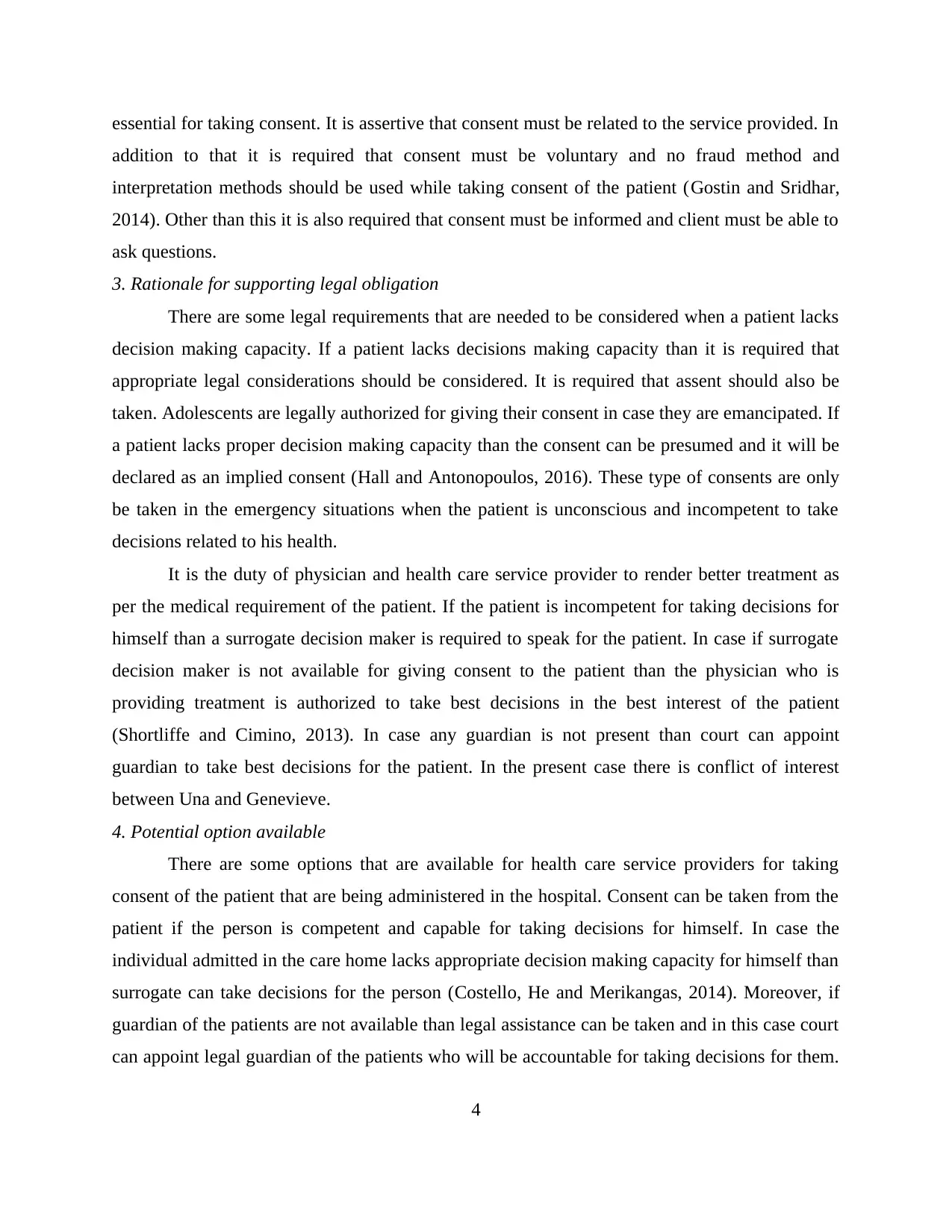
essential for taking consent. It is assertive that consent must be related to the service provided. In
addition to that it is required that consent must be voluntary and no fraud method and
interpretation methods should be used while taking consent of the patient (Gostin and Sridhar,
2014). Other than this it is also required that consent must be informed and client must be able to
ask questions.
3. Rationale for supporting legal obligation
There are some legal requirements that are needed to be considered when a patient lacks
decision making capacity. If a patient lacks decisions making capacity than it is required that
appropriate legal considerations should be considered. It is required that assent should also be
taken. Adolescents are legally authorized for giving their consent in case they are emancipated. If
a patient lacks proper decision making capacity than the consent can be presumed and it will be
declared as an implied consent (Hall and Antonopoulos, 2016). These type of consents are only
be taken in the emergency situations when the patient is unconscious and incompetent to take
decisions related to his health.
It is the duty of physician and health care service provider to render better treatment as
per the medical requirement of the patient. If the patient is incompetent for taking decisions for
himself than a surrogate decision maker is required to speak for the patient. In case if surrogate
decision maker is not available for giving consent to the patient than the physician who is
providing treatment is authorized to take best decisions in the best interest of the patient
(Shortliffe and Cimino, 2013). In case any guardian is not present than court can appoint
guardian to take best decisions for the patient. In the present case there is conflict of interest
between Una and Genevieve.
4. Potential option available
There are some options that are available for health care service providers for taking
consent of the patient that are being administered in the hospital. Consent can be taken from the
patient if the person is competent and capable for taking decisions for himself. In case the
individual admitted in the care home lacks appropriate decision making capacity for himself than
surrogate can take decisions for the person (Costello, He and Merikangas, 2014). Moreover, if
guardian of the patients are not available than legal assistance can be taken and in this case court
can appoint legal guardian of the patients who will be accountable for taking decisions for them.
4
addition to that it is required that consent must be voluntary and no fraud method and
interpretation methods should be used while taking consent of the patient (Gostin and Sridhar,
2014). Other than this it is also required that consent must be informed and client must be able to
ask questions.
3. Rationale for supporting legal obligation
There are some legal requirements that are needed to be considered when a patient lacks
decision making capacity. If a patient lacks decisions making capacity than it is required that
appropriate legal considerations should be considered. It is required that assent should also be
taken. Adolescents are legally authorized for giving their consent in case they are emancipated. If
a patient lacks proper decision making capacity than the consent can be presumed and it will be
declared as an implied consent (Hall and Antonopoulos, 2016). These type of consents are only
be taken in the emergency situations when the patient is unconscious and incompetent to take
decisions related to his health.
It is the duty of physician and health care service provider to render better treatment as
per the medical requirement of the patient. If the patient is incompetent for taking decisions for
himself than a surrogate decision maker is required to speak for the patient. In case if surrogate
decision maker is not available for giving consent to the patient than the physician who is
providing treatment is authorized to take best decisions in the best interest of the patient
(Shortliffe and Cimino, 2013). In case any guardian is not present than court can appoint
guardian to take best decisions for the patient. In the present case there is conflict of interest
between Una and Genevieve.
4. Potential option available
There are some options that are available for health care service providers for taking
consent of the patient that are being administered in the hospital. Consent can be taken from the
patient if the person is competent and capable for taking decisions for himself. In case the
individual admitted in the care home lacks appropriate decision making capacity for himself than
surrogate can take decisions for the person (Costello, He and Merikangas, 2014). Moreover, if
guardian of the patients are not available than legal assistance can be taken and in this case court
can appoint legal guardian of the patients who will be accountable for taking decisions for them.
4
Paraphrase This Document
Need a fresh take? Get an instant paraphrase of this document with our AI Paraphraser

Physicians who are providing medical services to the patients (Drummond, M.F. and et.al., 2015)
are also authorized for taking decisions for the patient in best interest of him.
5. Course of action
If there is disagreement between substitute decision makers than in this case there are
some options that are available for the health care practitioners. If there is disagreement between
substitute decision makes than in this case two specific options are available for the health care
practitioners (Gunn and Taylor, 2014). In the present case scenario Genevieve and Una are
having conflict of interest for taking decisions for the patients and Genevieve and team of
physicians believes that the treatment that is being provided to Edward should be stopped.
However Una believes that if better medical services should be provided to patient than it will
help for making significant improvements in the health conditions of Edward and so better
improvements can be gained.
6. Factors that will be taken into consideration
There are some particular factors that are needed to be taken into consideration while
making decisions as to whether Edward's life-sustaining measures can be withdrawn. It is vital
that health conditions of the patient should be properly assessed so that better decisions can be
taken about providing medical treatment to the medical service users (Drummond and et.al.,
2015). In addition to that it is vital that there should not be any conflict of interest among the
surrogate who are responsible for taking decisions for the patient.
It is assertive that consent should be taken from the medical service users so that better
and effective decisions should be taken and Edward should be provided with better medical
services and care. It is the prime responsibility of health care practitioners to ensure well being of
the patient and it becomes their duty to render proper medical services to the patients. Moreover,
Edward's consent can be presumed as it is an emergency situation and there is conflict of interest
among the guardians who are accountable for taking decisions for the patient.
ETHICAL ISSUES
1. Ethical principles related with this scenario
In the present scenario, Edward's mother is taking a stand against his wife's decision of
removing life support system. The perception of Edward's medical conditions has two sides. His
mother believes that he would be cured someday and hence life support machines must be
5
are also authorized for taking decisions for the patient in best interest of him.
5. Course of action
If there is disagreement between substitute decision makers than in this case there are
some options that are available for the health care practitioners. If there is disagreement between
substitute decision makes than in this case two specific options are available for the health care
practitioners (Gunn and Taylor, 2014). In the present case scenario Genevieve and Una are
having conflict of interest for taking decisions for the patients and Genevieve and team of
physicians believes that the treatment that is being provided to Edward should be stopped.
However Una believes that if better medical services should be provided to patient than it will
help for making significant improvements in the health conditions of Edward and so better
improvements can be gained.
6. Factors that will be taken into consideration
There are some particular factors that are needed to be taken into consideration while
making decisions as to whether Edward's life-sustaining measures can be withdrawn. It is vital
that health conditions of the patient should be properly assessed so that better decisions can be
taken about providing medical treatment to the medical service users (Drummond and et.al.,
2015). In addition to that it is vital that there should not be any conflict of interest among the
surrogate who are responsible for taking decisions for the patient.
It is assertive that consent should be taken from the medical service users so that better
and effective decisions should be taken and Edward should be provided with better medical
services and care. It is the prime responsibility of health care practitioners to ensure well being of
the patient and it becomes their duty to render proper medical services to the patients. Moreover,
Edward's consent can be presumed as it is an emergency situation and there is conflict of interest
among the guardians who are accountable for taking decisions for the patient.
ETHICAL ISSUES
1. Ethical principles related with this scenario
In the present scenario, Edward's mother is taking a stand against his wife's decision of
removing life support system. The perception of Edward's medical conditions has two sides. His
mother believes that he would be cured someday and hence life support machines must be
5
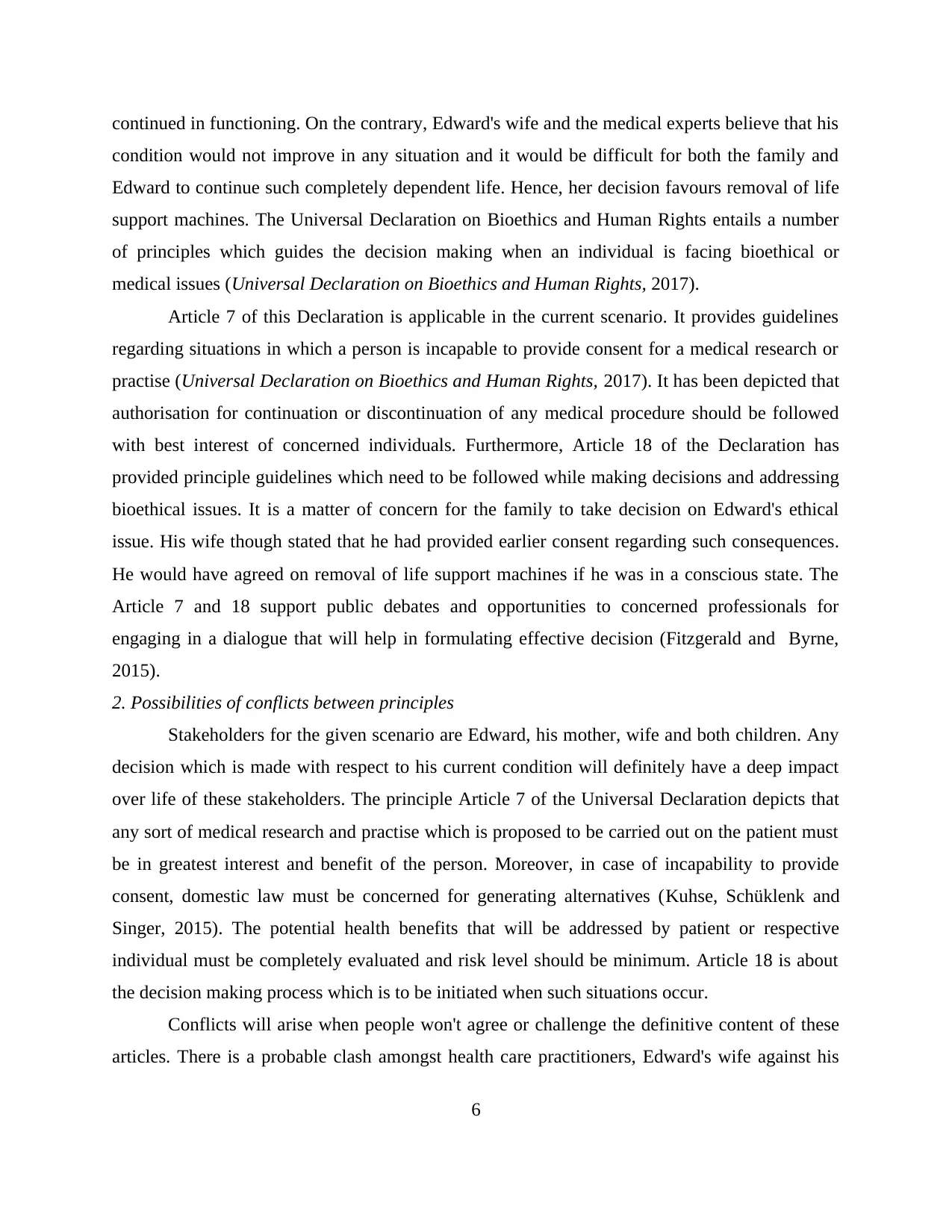
continued in functioning. On the contrary, Edward's wife and the medical experts believe that his
condition would not improve in any situation and it would be difficult for both the family and
Edward to continue such completely dependent life. Hence, her decision favours removal of life
support machines. The Universal Declaration on Bioethics and Human Rights entails a number
of principles which guides the decision making when an individual is facing bioethical or
medical issues (Universal Declaration on Bioethics and Human Rights, 2017).
Article 7 of this Declaration is applicable in the current scenario. It provides guidelines
regarding situations in which a person is incapable to provide consent for a medical research or
practise (Universal Declaration on Bioethics and Human Rights, 2017). It has been depicted that
authorisation for continuation or discontinuation of any medical procedure should be followed
with best interest of concerned individuals. Furthermore, Article 18 of the Declaration has
provided principle guidelines which need to be followed while making decisions and addressing
bioethical issues. It is a matter of concern for the family to take decision on Edward's ethical
issue. His wife though stated that he had provided earlier consent regarding such consequences.
He would have agreed on removal of life support machines if he was in a conscious state. The
Article 7 and 18 support public debates and opportunities to concerned professionals for
engaging in a dialogue that will help in formulating effective decision (Fitzgerald and Byrne,
2015).
2. Possibilities of conflicts between principles
Stakeholders for the given scenario are Edward, his mother, wife and both children. Any
decision which is made with respect to his current condition will definitely have a deep impact
over life of these stakeholders. The principle Article 7 of the Universal Declaration depicts that
any sort of medical research and practise which is proposed to be carried out on the patient must
be in greatest interest and benefit of the person. Moreover, in case of incapability to provide
consent, domestic law must be concerned for generating alternatives (Kuhse, Schüklenk and
Singer, 2015). The potential health benefits that will be addressed by patient or respective
individual must be completely evaluated and risk level should be minimum. Article 18 is about
the decision making process which is to be initiated when such situations occur.
Conflicts will arise when people won't agree or challenge the definitive content of these
articles. There is a probable clash amongst health care practitioners, Edward's wife against his
6
condition would not improve in any situation and it would be difficult for both the family and
Edward to continue such completely dependent life. Hence, her decision favours removal of life
support machines. The Universal Declaration on Bioethics and Human Rights entails a number
of principles which guides the decision making when an individual is facing bioethical or
medical issues (Universal Declaration on Bioethics and Human Rights, 2017).
Article 7 of this Declaration is applicable in the current scenario. It provides guidelines
regarding situations in which a person is incapable to provide consent for a medical research or
practise (Universal Declaration on Bioethics and Human Rights, 2017). It has been depicted that
authorisation for continuation or discontinuation of any medical procedure should be followed
with best interest of concerned individuals. Furthermore, Article 18 of the Declaration has
provided principle guidelines which need to be followed while making decisions and addressing
bioethical issues. It is a matter of concern for the family to take decision on Edward's ethical
issue. His wife though stated that he had provided earlier consent regarding such consequences.
He would have agreed on removal of life support machines if he was in a conscious state. The
Article 7 and 18 support public debates and opportunities to concerned professionals for
engaging in a dialogue that will help in formulating effective decision (Fitzgerald and Byrne,
2015).
2. Possibilities of conflicts between principles
Stakeholders for the given scenario are Edward, his mother, wife and both children. Any
decision which is made with respect to his current condition will definitely have a deep impact
over life of these stakeholders. The principle Article 7 of the Universal Declaration depicts that
any sort of medical research and practise which is proposed to be carried out on the patient must
be in greatest interest and benefit of the person. Moreover, in case of incapability to provide
consent, domestic law must be concerned for generating alternatives (Kuhse, Schüklenk and
Singer, 2015). The potential health benefits that will be addressed by patient or respective
individual must be completely evaluated and risk level should be minimum. Article 18 is about
the decision making process which is to be initiated when such situations occur.
Conflicts will arise when people won't agree or challenge the definitive content of these
articles. There is a probable clash amongst health care practitioners, Edward's wife against his
6
⊘ This is a preview!⊘
Do you want full access?
Subscribe today to unlock all pages.

Trusted by 1+ million students worldwide
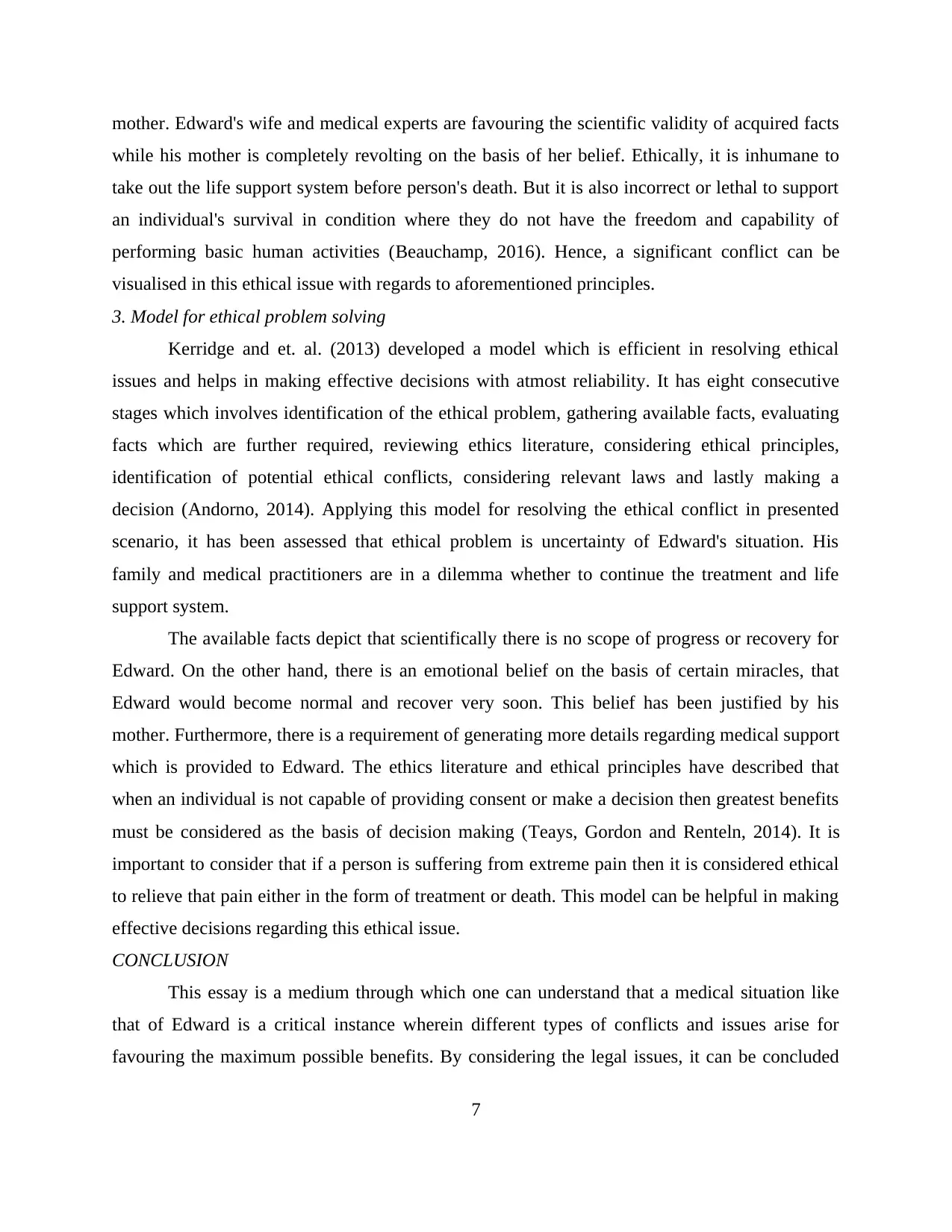
mother. Edward's wife and medical experts are favouring the scientific validity of acquired facts
while his mother is completely revolting on the basis of her belief. Ethically, it is inhumane to
take out the life support system before person's death. But it is also incorrect or lethal to support
an individual's survival in condition where they do not have the freedom and capability of
performing basic human activities (Beauchamp, 2016). Hence, a significant conflict can be
visualised in this ethical issue with regards to aforementioned principles.
3. Model for ethical problem solving
Kerridge and et. al. (2013) developed a model which is efficient in resolving ethical
issues and helps in making effective decisions with atmost reliability. It has eight consecutive
stages which involves identification of the ethical problem, gathering available facts, evaluating
facts which are further required, reviewing ethics literature, considering ethical principles,
identification of potential ethical conflicts, considering relevant laws and lastly making a
decision (Andorno, 2014). Applying this model for resolving the ethical conflict in presented
scenario, it has been assessed that ethical problem is uncertainty of Edward's situation. His
family and medical practitioners are in a dilemma whether to continue the treatment and life
support system.
The available facts depict that scientifically there is no scope of progress or recovery for
Edward. On the other hand, there is an emotional belief on the basis of certain miracles, that
Edward would become normal and recover very soon. This belief has been justified by his
mother. Furthermore, there is a requirement of generating more details regarding medical support
which is provided to Edward. The ethics literature and ethical principles have described that
when an individual is not capable of providing consent or make a decision then greatest benefits
must be considered as the basis of decision making (Teays, Gordon and Renteln, 2014). It is
important to consider that if a person is suffering from extreme pain then it is considered ethical
to relieve that pain either in the form of treatment or death. This model can be helpful in making
effective decisions regarding this ethical issue.
CONCLUSION
This essay is a medium through which one can understand that a medical situation like
that of Edward is a critical instance wherein different types of conflicts and issues arise for
favouring the maximum possible benefits. By considering the legal issues, it can be concluded
7
while his mother is completely revolting on the basis of her belief. Ethically, it is inhumane to
take out the life support system before person's death. But it is also incorrect or lethal to support
an individual's survival in condition where they do not have the freedom and capability of
performing basic human activities (Beauchamp, 2016). Hence, a significant conflict can be
visualised in this ethical issue with regards to aforementioned principles.
3. Model for ethical problem solving
Kerridge and et. al. (2013) developed a model which is efficient in resolving ethical
issues and helps in making effective decisions with atmost reliability. It has eight consecutive
stages which involves identification of the ethical problem, gathering available facts, evaluating
facts which are further required, reviewing ethics literature, considering ethical principles,
identification of potential ethical conflicts, considering relevant laws and lastly making a
decision (Andorno, 2014). Applying this model for resolving the ethical conflict in presented
scenario, it has been assessed that ethical problem is uncertainty of Edward's situation. His
family and medical practitioners are in a dilemma whether to continue the treatment and life
support system.
The available facts depict that scientifically there is no scope of progress or recovery for
Edward. On the other hand, there is an emotional belief on the basis of certain miracles, that
Edward would become normal and recover very soon. This belief has been justified by his
mother. Furthermore, there is a requirement of generating more details regarding medical support
which is provided to Edward. The ethics literature and ethical principles have described that
when an individual is not capable of providing consent or make a decision then greatest benefits
must be considered as the basis of decision making (Teays, Gordon and Renteln, 2014). It is
important to consider that if a person is suffering from extreme pain then it is considered ethical
to relieve that pain either in the form of treatment or death. This model can be helpful in making
effective decisions regarding this ethical issue.
CONCLUSION
This essay is a medium through which one can understand that a medical situation like
that of Edward is a critical instance wherein different types of conflicts and issues arise for
favouring the maximum possible benefits. By considering the legal issues, it can be concluded
7
Paraphrase This Document
Need a fresh take? Get an instant paraphrase of this document with our AI Paraphraser

that physicians hold the responsibility of taking a decision because Una and Genevieve are
facing conflicts of interest. On the other hand, ethical considerations and principles depict that
public debate and opportunities to pluralistic groups must be provided for evaluating different
aspects of Edward's situation.
8
facing conflicts of interest. On the other hand, ethical considerations and principles depict that
public debate and opportunities to pluralistic groups must be provided for evaluating different
aspects of Edward's situation.
8
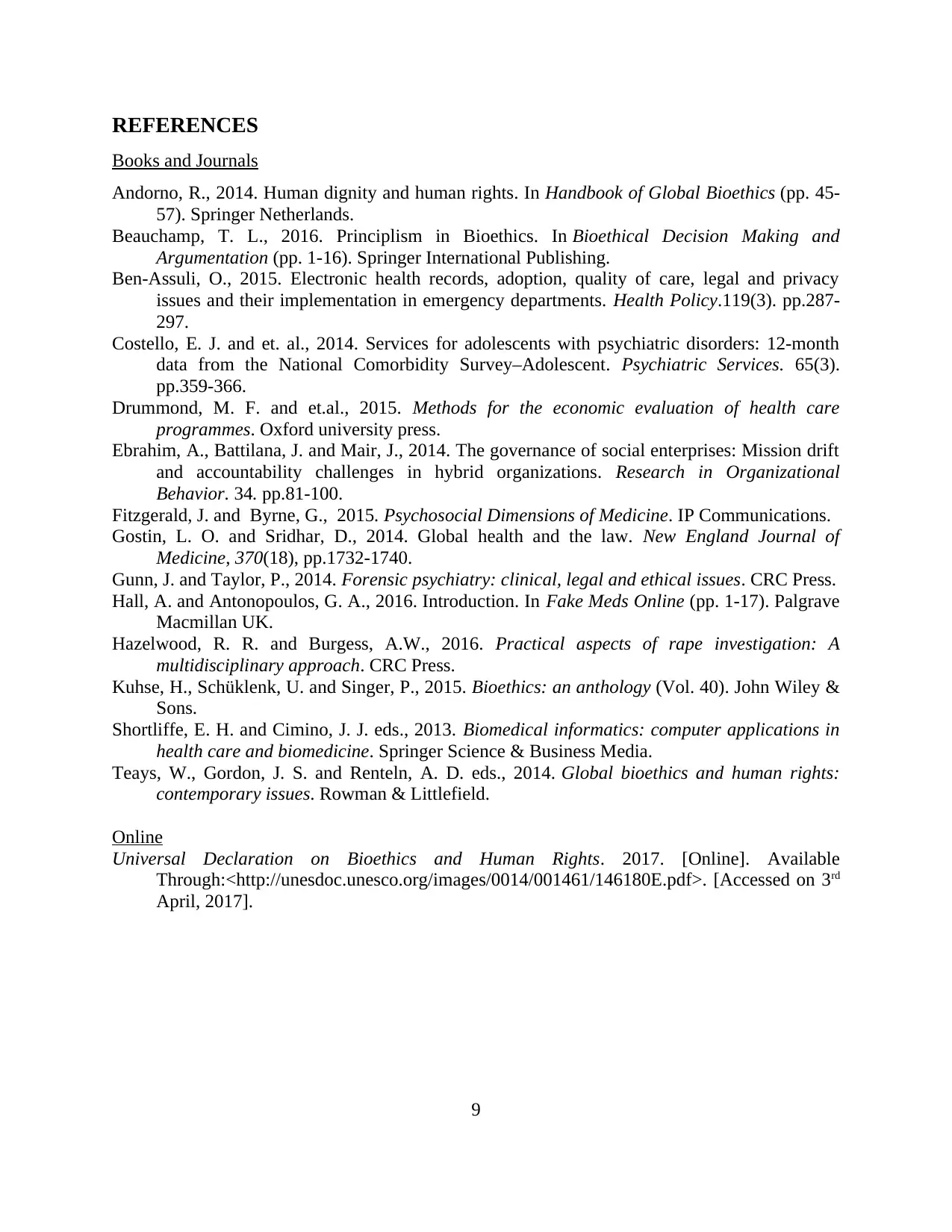
REFERENCES
Books and Journals
Andorno, R., 2014. Human dignity and human rights. In Handbook of Global Bioethics (pp. 45-
57). Springer Netherlands.
Beauchamp, T. L., 2016. Principlism in Bioethics. In Bioethical Decision Making and
Argumentation (pp. 1-16). Springer International Publishing.
Ben-Assuli, O., 2015. Electronic health records, adoption, quality of care, legal and privacy
issues and their implementation in emergency departments. Health Policy.119(3). pp.287-
297.
Costello, E. J. and et. al., 2014. Services for adolescents with psychiatric disorders: 12-month
data from the National Comorbidity Survey–Adolescent. Psychiatric Services. 65(3).
pp.359-366.
Drummond, M. F. and et.al., 2015. Methods for the economic evaluation of health care
programmes. Oxford university press.
Ebrahim, A., Battilana, J. and Mair, J., 2014. The governance of social enterprises: Mission drift
and accountability challenges in hybrid organizations. Research in Organizational
Behavior. 34. pp.81-100.
Fitzgerald, J. and Byrne, G., 2015. Psychosocial Dimensions of Medicine. IP Communications.
Gostin, L. O. and Sridhar, D., 2014. Global health and the law. New England Journal of
Medicine, 370(18), pp.1732-1740.
Gunn, J. and Taylor, P., 2014. Forensic psychiatry: clinical, legal and ethical issues. CRC Press.
Hall, A. and Antonopoulos, G. A., 2016. Introduction. In Fake Meds Online (pp. 1-17). Palgrave
Macmillan UK.
Hazelwood, R. R. and Burgess, A.W., 2016. Practical aspects of rape investigation: A
multidisciplinary approach. CRC Press.
Kuhse, H., Schüklenk, U. and Singer, P., 2015. Bioethics: an anthology (Vol. 40). John Wiley &
Sons.
Shortliffe, E. H. and Cimino, J. J. eds., 2013. Biomedical informatics: computer applications in
health care and biomedicine. Springer Science & Business Media.
Teays, W., Gordon, J. S. and Renteln, A. D. eds., 2014. Global bioethics and human rights:
contemporary issues. Rowman & Littlefield.
Online
Universal Declaration on Bioethics and Human Rights. 2017. [Online]. Available
Through:<http://unesdoc.unesco.org/images/0014/001461/146180E.pdf>. [Accessed on 3rd
April, 2017].
9
Books and Journals
Andorno, R., 2014. Human dignity and human rights. In Handbook of Global Bioethics (pp. 45-
57). Springer Netherlands.
Beauchamp, T. L., 2016. Principlism in Bioethics. In Bioethical Decision Making and
Argumentation (pp. 1-16). Springer International Publishing.
Ben-Assuli, O., 2015. Electronic health records, adoption, quality of care, legal and privacy
issues and their implementation in emergency departments. Health Policy.119(3). pp.287-
297.
Costello, E. J. and et. al., 2014. Services for adolescents with psychiatric disorders: 12-month
data from the National Comorbidity Survey–Adolescent. Psychiatric Services. 65(3).
pp.359-366.
Drummond, M. F. and et.al., 2015. Methods for the economic evaluation of health care
programmes. Oxford university press.
Ebrahim, A., Battilana, J. and Mair, J., 2014. The governance of social enterprises: Mission drift
and accountability challenges in hybrid organizations. Research in Organizational
Behavior. 34. pp.81-100.
Fitzgerald, J. and Byrne, G., 2015. Psychosocial Dimensions of Medicine. IP Communications.
Gostin, L. O. and Sridhar, D., 2014. Global health and the law. New England Journal of
Medicine, 370(18), pp.1732-1740.
Gunn, J. and Taylor, P., 2014. Forensic psychiatry: clinical, legal and ethical issues. CRC Press.
Hall, A. and Antonopoulos, G. A., 2016. Introduction. In Fake Meds Online (pp. 1-17). Palgrave
Macmillan UK.
Hazelwood, R. R. and Burgess, A.W., 2016. Practical aspects of rape investigation: A
multidisciplinary approach. CRC Press.
Kuhse, H., Schüklenk, U. and Singer, P., 2015. Bioethics: an anthology (Vol. 40). John Wiley &
Sons.
Shortliffe, E. H. and Cimino, J. J. eds., 2013. Biomedical informatics: computer applications in
health care and biomedicine. Springer Science & Business Media.
Teays, W., Gordon, J. S. and Renteln, A. D. eds., 2014. Global bioethics and human rights:
contemporary issues. Rowman & Littlefield.
Online
Universal Declaration on Bioethics and Human Rights. 2017. [Online]. Available
Through:<http://unesdoc.unesco.org/images/0014/001461/146180E.pdf>. [Accessed on 3rd
April, 2017].
9
⊘ This is a preview!⊘
Do you want full access?
Subscribe today to unlock all pages.

Trusted by 1+ million students worldwide
1 out of 9
Related Documents
Your All-in-One AI-Powered Toolkit for Academic Success.
+13062052269
info@desklib.com
Available 24*7 on WhatsApp / Email
![[object Object]](/_next/static/media/star-bottom.7253800d.svg)
Unlock your academic potential
Copyright © 2020–2025 A2Z Services. All Rights Reserved. Developed and managed by ZUCOL.




